Tired of hearing the “be omnichannel” mantra, only to end up with a slew of social media accounts that yield nothing but crickets? Having a presence on every platform isn’t the same as effective social media management. It’s important for you to shift your focus from mere presence to meaningful engagement and tangible results.
What is social media management (SMM)? Social media management is the art and science of crafting content, scheduling posts, and analyzing results across the right platforms to achieve specific business goals. It's more than just bragging. It's about building brand awareness, connecting with customers, and driving sales.
Unlike the other generic social media management blogs, we won’t advise you to “post consistently.” We’re here to deliver actionable tips and real-world strategies that drive results.
This guide provides a practical tool, our recommended strategies, and all the know-how to tailor your plan for maximum impact with real-time:
- Social media ROI calculator
- Social media calendar template
Bookmark this blog to know our expert-approved insights to turn followers into customers with social media reputation management.
Table of contents
- Why is social media management important for businesses?
- What are the benefits of social media management?
- Popular social media platforms and which is the right one for you
- What is social media marketing?
- Types of social media marketing
- Paid or organic social media marketing: Which business should choose what at which stage?
- The foundation to building a strong social media presence: Have a social media strategy
- How companies should approach social media content creation
- Common social media marketing challenges faced by businesses
- The social media cycle to turn followers into customers
- What is the best way to analyze data on social media metrics?
- Top 4 free social media management tools
- If you can get all data from free tools, are paid social media management platforms worth the investment?
- Solve any challenge smartly with Birdeye’s AI-powered social media management tool
- Latest social media trends & how businesses can adapt
- FAQs about social media management
- Simplify social media management with Birdeye
Why is social media management important for businesses?
As we highlighted in the beginning, you may have social media profiles on all the popular platforms, but if you don’t know which channel is more important, you will waste time and energy.
Investing in social media management isn’t just a fad; it’s a strategic decision. It helps you navigate the ever-evolving social media landscape and turn your online presence into a powerful tool for growth.
Imagine your ideal social media presence: Consistent, engaging, and attracting the right audience. That’s why social media management is essential for your business.
Think of it as your project manager – coordinating your activities across various platforms to achieve your overarching business goals.
Here’s how it benefits your brand:
‣ Targeting the right audience
‣ Strategic posting & scheduling
‣ Data-driven decisions
‣ Support during crisis communication
Let’s discuss their impact in detail.
Targeting the right audience: Not all platforms are created equal. Imagine posting business updates on TikTok—you might get some laughs but not many leads. Social media management helps identify which platforms resonate best with your target audience, ensuring your message reaches the right eye.
Strategic posting & scheduling: Consistency is key, but bombarding feeds is a fast track to “unfollowing.” Many tools help you create a content calendar and schedule posts in advance, ensuring a steady stream of engaging content without overwhelming your followers.
Data-driven decisions: Success isn’t about guesswork. Social media management tools track engagement metrics like likes, comments, and shares, providing valuable data on what works and what flops. This feedback loop lets you refine your strategy and keep your audience hooked.
Support during crisis communication: Online things move fast, and sometimes they can go awry. Social media management helps you develop a reputational risk action plan, ensuring you’re prepared to address negativity and turn it into a positive PR moment.
Why is social media management so important right now? Social media management is crucial right now due to these platforms' unprecedented scale and influence. Effective management is vital to ensure content visibility as organic reach declines due to complex algorithms. It has become a customer’s go-to platform for product discovery, customer service, and direct sales through emerging social commerce. Proficient social media management is essential for businesses to remain competitive and relevant, and it helps in real-time marketing and crisis management.
What are the benefits of social media management?
Forget outsourcing! Imagine transforming your social media presence into a well-oiled machine yourself. Attract new customers, boost brand loyalty, and gain valuable insights – all without the constant content scramble.
Social media management isn’t magic (although the results can be mesmerizing!). It’s about strategic planning, creativity, and a deep understanding of your audience.
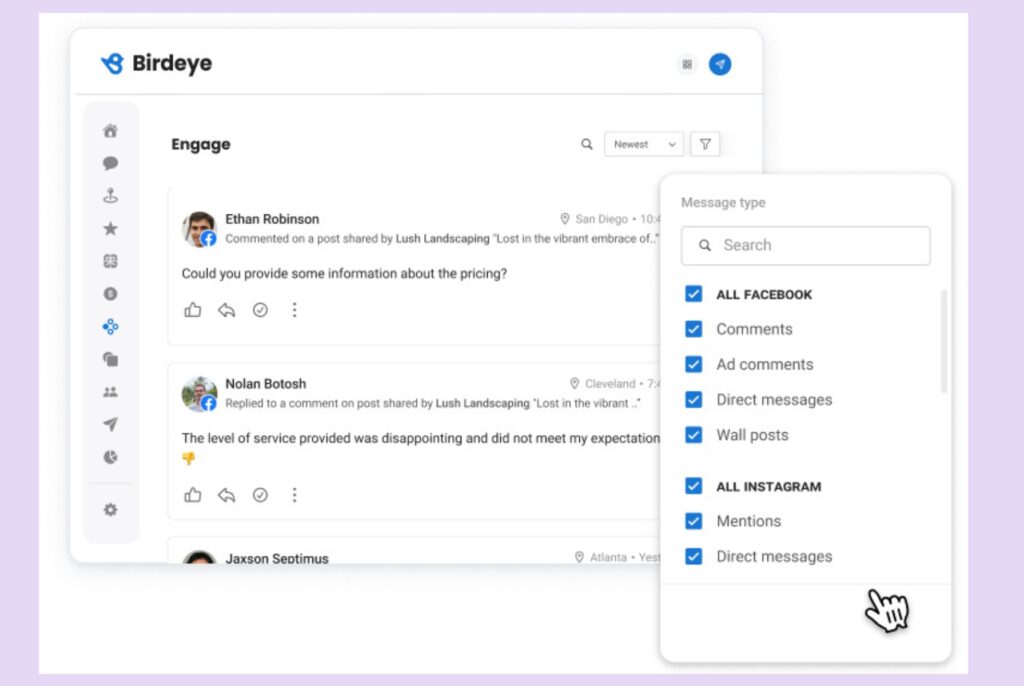
Here’s how it benefits your business and brand:
- Enhances brand visibility and awareness
- Drives targeted traffic to your website
- Improves customer engagement and builds loyalty
- Establishes you as a thought leader
- Boosts SEO performance
- Facilitates cost-effective marketing
- Provides competitive advantage
Let’s discuss these in detail.
Enhances brand visibility and awareness
Effective social media management puts your brand before a vast, engaged audience. These platforms offer unparalleled opportunities to increase brand visibility. By consistently sharing valuable content and engaging with your audience, you can build brand perception and stay top-of-mind with potential customers.
Drives targeted traffic to your website
Social media platforms serve as powerful conduits for driving traffic to your website. You can direct interested users to your site through strategic content sharing and paid advertising, potentially increasing conversions and sales.
Improves customer engagement and builds brand loyalty
Social media provides a two-way conversation with your customers. Proper management of these channels allows you to respond promptly to inquiries, address concerns, and engage in meaningful communication. This level of interaction can significantly enhance customer satisfaction and foster brand advocates.
Establishes you as a thought leader
Social media is a fantastic platform for sharing valuable content, such as blog posts, infographics, videos, and product demos. This form of content marketing educates your audience and establishes you as a thought leader.
Boosts SEO performance
While social media signals aren’t direct ranking factors, they indirectly influence your SEO reputation management. Quality content shared on social media can earn backlinks, increase brand mentions, and drive traffic—all of which can positively impact your SEO performance.
Facilitates cost-effective marketing
Social media offers a highly cost-effective way to reach your target audience compared to traditional marketing channels. With the right social media management strategy, you can do hyperlocal social media marketing and compete with larger corporations, achieving significant reach and engagement without breaking the bank.
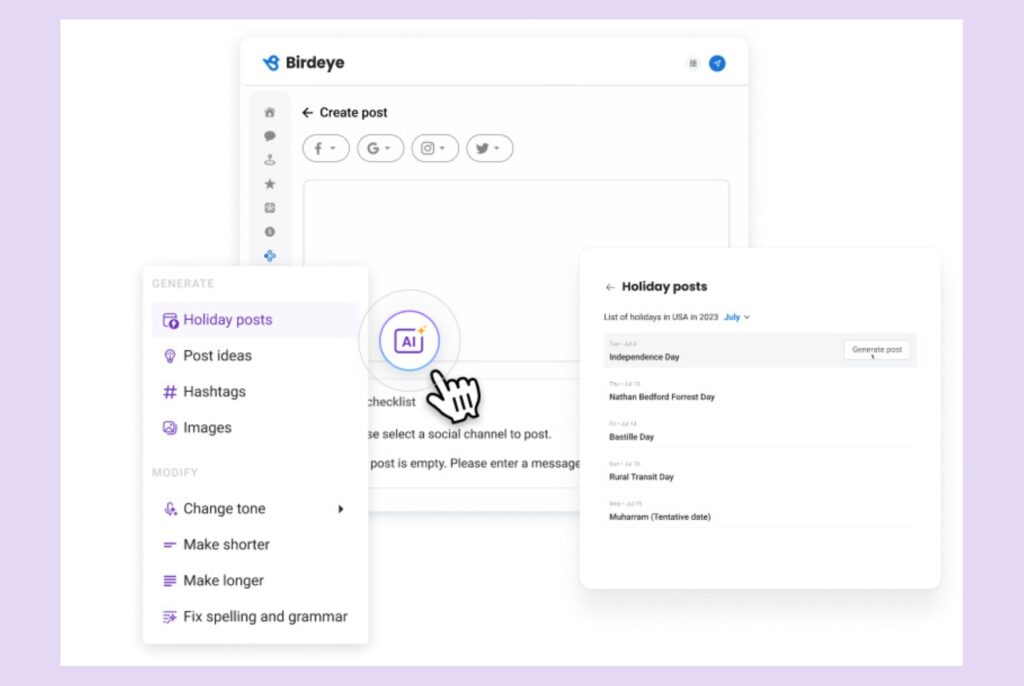
Offers valuable customer insights
Social media platforms are treasure troves of customer data. With the right social media management approach, you can gain insights into your audience’s preferences, behaviors, and pain points. This customer feedback insights is invaluable for refining your marketing strategies, product development, and overall business decisions.
Provides competitive advantage
By actively managing your social media presence, you can surpass your competitors who may be neglecting these platforms. You can monitor industry trends, monitor competitors’ strategies, and position your brand as a leader in your field.
Businesses prioritizing social media management are better positioned to connect with their audience, achieve their marketing goals, and drive sustainable growth.
Now that the basics are clear, let’s understand…
Popular social media platforms and which is the right one for you
When choosing a social media platform for your business, there are many things to consider. Each platform has its unique user base and set of features, so it’s important to select the one that best suits your needs.
Here’s an overview of some of the most popular social media platforms that could benefit your business.

For information on how to get started with Facebook, check out our most recent articles:
- Facebook marketing: Everything you need to know
- How to get verified on Facebook in just 7 steps
- How to get more Facebook likes: 12 tips that really work
- Connect with your customers using Facebook Business Manager
- 450+ Facebook bio ideas to wow customers across industries & professions
- The ultimate guide to Facebook Shops in 2024
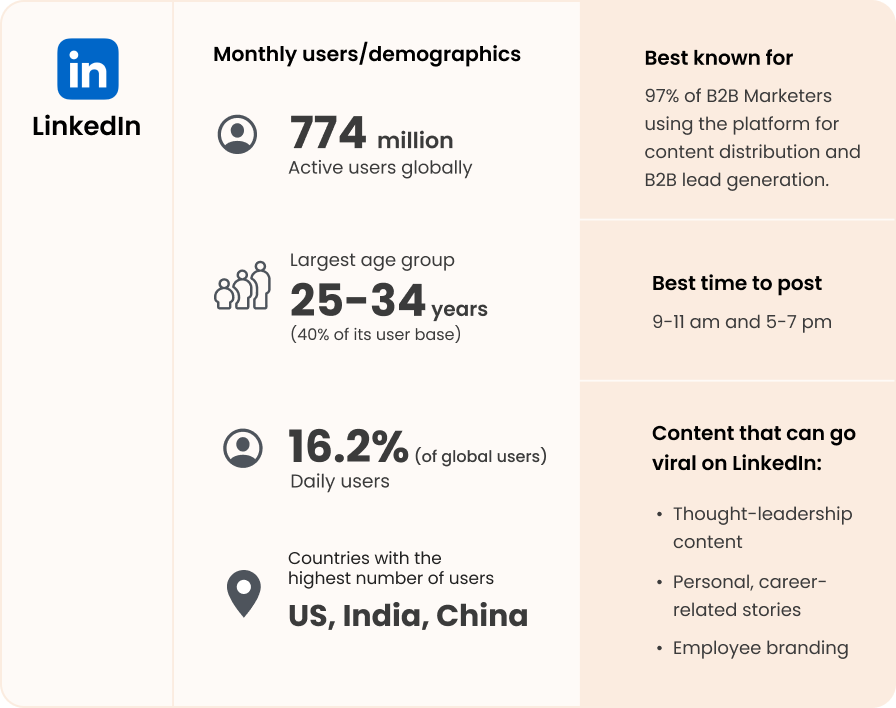
LinkedIn is focused on business and professional networking, making it a natural choice for companies looking to promote their products and services. You can create a LinkedIn Business Page and share social media content with your audience to help generate leads or increase brand awareness. Plus, learn about LinkedIn marketing hacks to grow your business.
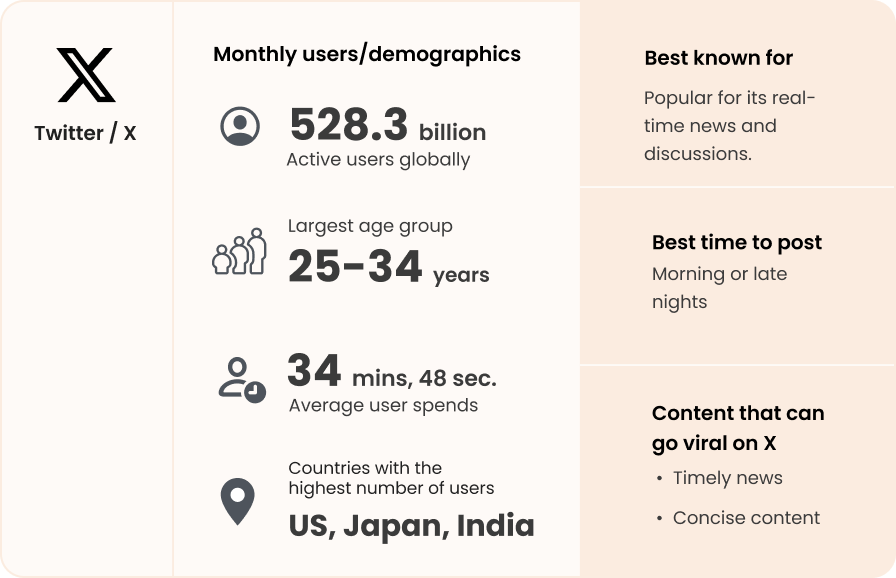
Twitter is fast-paced and offers many opportunities for real-time engagement. This is perfect for businesses that want to capitalize on current trends or news stories.
For information on how to use Twitter to get more customers and loyal followers, check out our most recent articles:
- How to create an impactful Twitter business profile
- Decoding Twitter Impressions: Your gateway to greater engagement
- 4 Tips to boost your Twitter marketing strategy
- Best times to post on Twitter for your business
YouTube
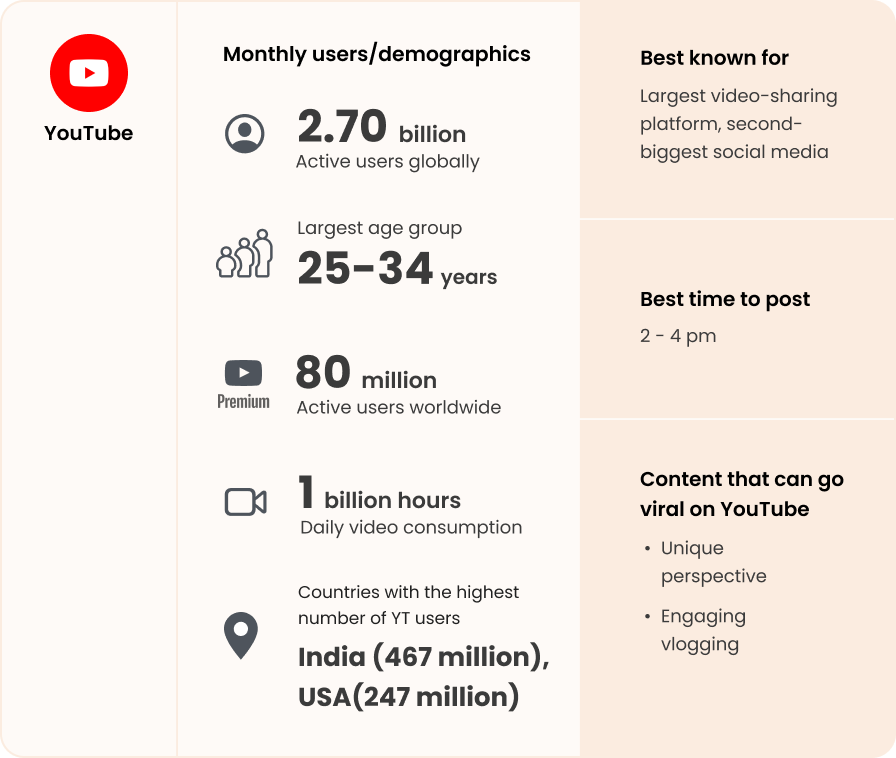
YouTube is unique because it’s primarily a video-based platform. Whether short or long-form, video is the preferred way to consume social media content. Because of this, it’s a popular choice for both businesses and consumers.
For information on how to use YouTube to get more customers and loyal followers, check out our most recent articles:
- The best time to post on YouTube to get more views & subscribers
- How to get verified on YouTube & build your digital legacy
- Why you should unlist, not delete, your YouTube videos

Instagram lets you visually showcase your products or services using high-quality photos and videos. Instagram Stories and Instagram Live provide businesses with additional opportunities to increase engagement and connect with potential customers.
For information on how to use Instagram to get more customers and loyal followers, check out our most recent articles:
- Instagram marketing guide for business accounts
- How to get verified on Instagram with the blue check mark
- How to get more followers on Instagram: 12 smart tips
- Elevate your brand with a winning Instagram Business Account strategy
- 400+ creative Instagram bio ideas to boost your business’s digital appeal
Social media platforms are rapidly evolving into shopping destinations. Features like Instagram Shopping, Facebook Marketplace, and TikTok Shop have blurred the lines between social networking and eCommerce, making social media management essential for driving sales directly through these platforms.
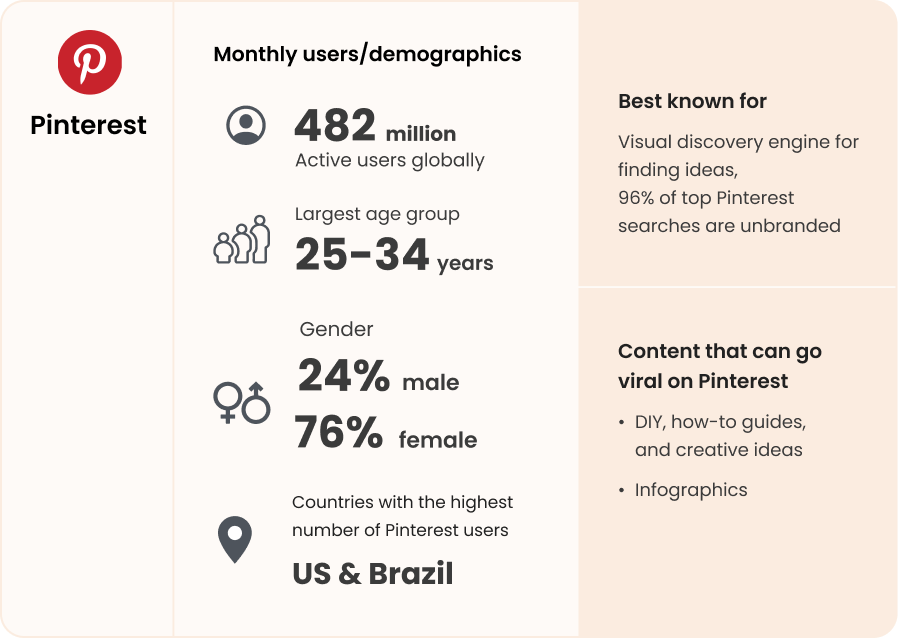
Pinterest is particularly well-suited for businesses specializing in visual media, such as fashion, design, and food. However, even businesses without a strong visual component can find ways to capitalize on Pinterest’s popularity.
For information on how to use Pinterest to get more customers and loyal followers, check out our most recent articles:
- How to get followers on Pinterest: 25 proven strategies for 2024
- How to reach new customers with a Pinterest business account [Guide]
TikTok
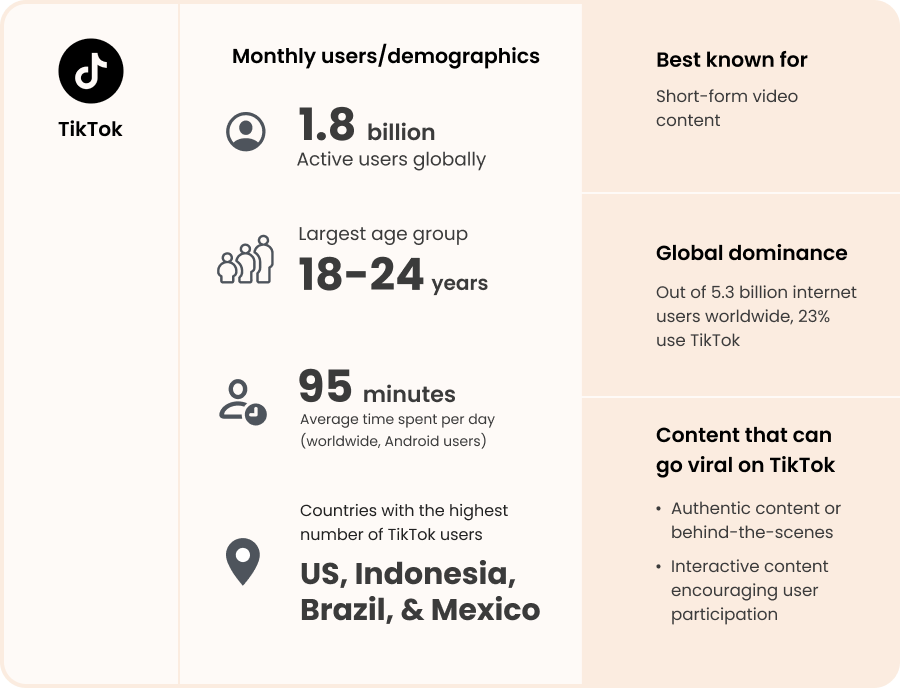
TikTok offers a unique opportunity to connect with potential customers through short-form video clips. Users are typically creative and open-minded, which makes it very popular amongst the younger crowd – specifically Gen Z and millennials.
Snapchat
Snapchat sends disappearing messages that can only be viewed for a limited time. This creates a sense of urgency and can help businesses to stand out from the competition.
Must read: How to see Snapchat Memories & boost your brand visibility
Here are two honorable social media platforms: Reddit and Discord.
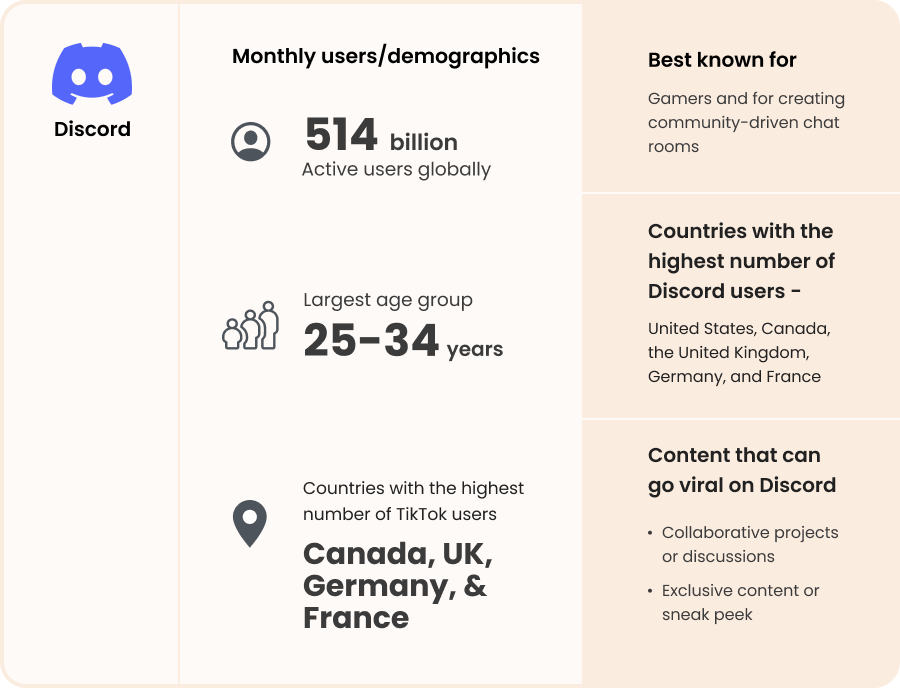
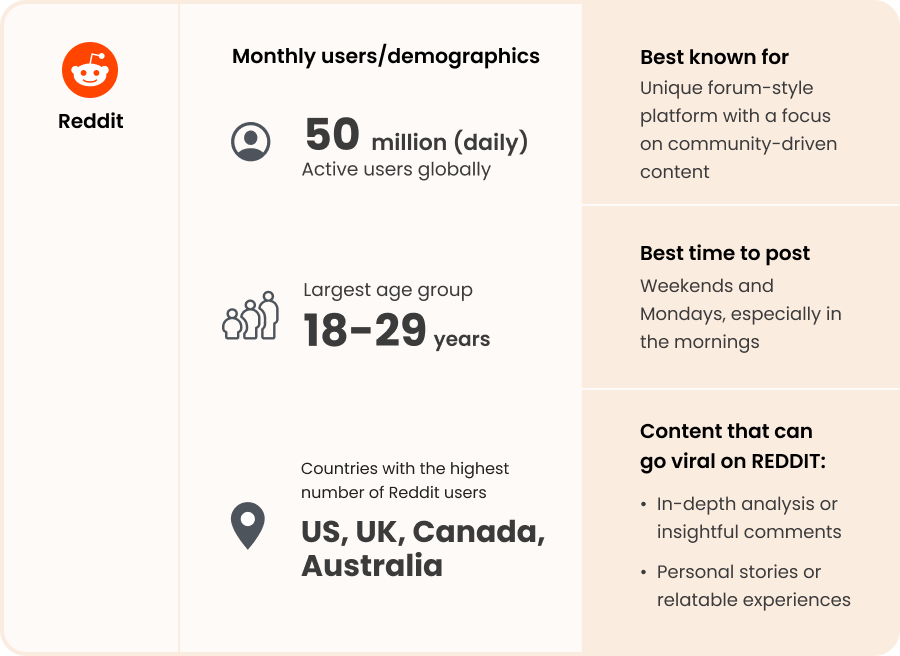

What is social media marketing?
Social media marketing is using social media platforms to connect with your audience, build your brand, and achieve specific business goals. It involves creating and sharing engaging content, fostering conversations, and analyzing data to measure success.
Effective social media management ensures marketing efforts across various platforms are coordinated, consistent, and aligned with your business goals.
In-house or agency? Know THE solution for 360° social media management in the UK
Benefits of social media marketing include:
- Partnering with industry leaders to tap into their established audience and gain wider exposure can accelerate brand awareness and audience growth.
- Boosting trust with user-generated content such as customer testimonials and brand mentions to build authenticity and social proof drives buying decisions.
- Leveraging in-app purchase features to streamline the buying journey. A frictionless buying experience increases sales conversion.
- Building a sense of urgency with limited-time discounts, encouraging impulsive purchases, and boosting sales as these offers incentivize immediate action.
- Connecting emotionally with audiences by sharing your company narrative is a hallmark of memorable brand storytelling that fosters long-term brand loyalty.
- Gaining market insights by tracking industry trends and customer conversations to understand evolving needs and use them for strategic marketing and product development.
- Maximize ROI with targeted ads for laser-focused advertising campaigns, ensuring you reach the right people and campaign effectiveness.
Now that you know the benefits of social media marketing, did you know there’s an amazing platform that makes managing your social accounts a breeze? It’s Birdeye Social!
Whether posting content, chatting with followers, or trying to figure out what’s working, Birdeye Social’s got your back.
Read how one of our customers benefited ever since using Birdeye Social:
Our customers, their stories: Birdeye Social has been huge in keeping me organized as a social media manager for 90 Facebook pages. I know that everything is in one place and organized, and it's been a huge time-saver! – Riley Torrence, Social Media Manager, Pacifica Senior
Types of social media marketing
Social media marketing can be broadly categorized into two approaches: organic and paid.
- Organic social media marketing
- Paid social media marketing
Let’s get into detail:
Organic social media marketing
Organic social media marketing focuses on building a following and engagement through unpaid strategies, such as creating engaging content, interacting with followers, and participating in conversations.
Advantages of organic social media marketing
- Builds authentic brand voice and connects on a deeper level.
- Fosters community engagement.
- Boosts long-term SEO benefits.
- Cost-effective growth strategy.
KPIs for organic social media:
- Social media reach (how many people see your content)
- Engagement (likes, comments, shares),
- Website Traffic (clicks to your website)
Check out the 15 Social media engagement posts your company should try
Paid social media marketing
Paid social media marketing leverages paid advertising to reach a wider audience and achieve specific goals.
How it works: You create ads (images, videos, etc.) targeting specific social media demographics, interests, and behaviors. People who see your ads can click through to your website or landing page.
Advantages of paid social media marketing
- Achieves laser targeting, reaching the exact audience you want.
- Enables rapid testing and results for campaign optimization.
- Get your content seen by a much wider audience.
- Drives specific actions and conversions, like sales or website visits.
Best practices when doing a paid campaign:
✅Clearly define your target audience and goals.
✅Create compelling ad copy and visuals.
✅Set realistic budgets and track results to optimize campaigns.
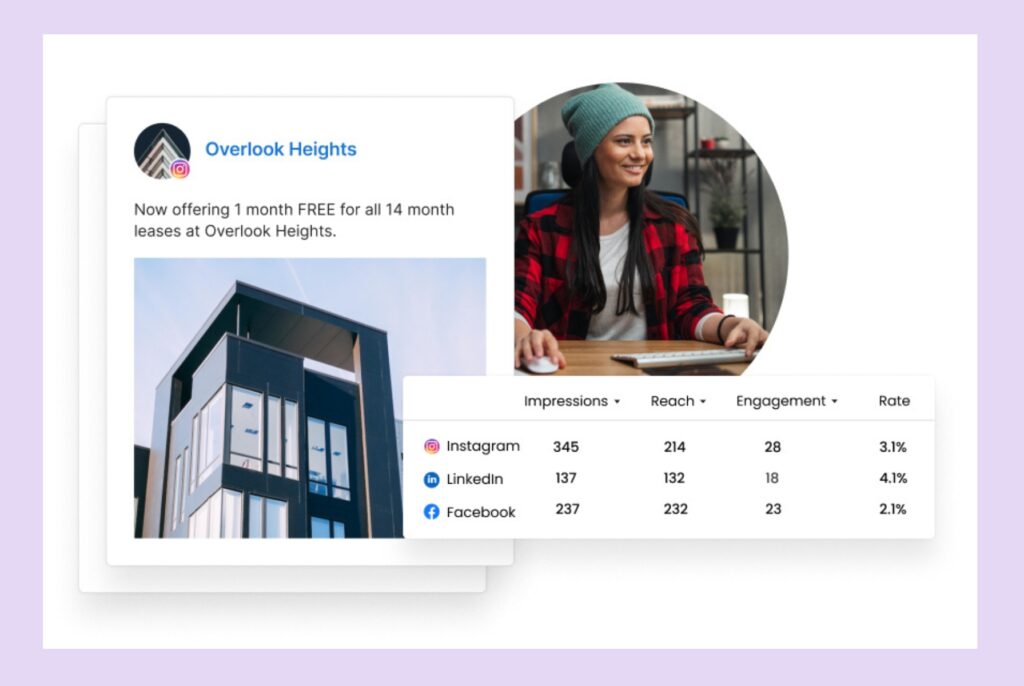
KPIs for paid social media
- Click-through rate (CTR) (how many people click on your ad)
- Conversion rate (percentage of clicks that lead to a desired action)
- Cost per acquisition (CPA) (average cost to acquire a customer through paid ads).
No more FOMO: Know these 200+ social media acronyms to speak like a pro!
What is social media ROI?
Social media ROI (Return on Investment) is a metric that measures the value you get from your social media marketing efforts compared to the resources you invest in it. It essentially helps you understand how effective your social media strategy is in achieving your business goals.
Here’s a breakdown:
- Return: This refers to the benefits you gain from social media, such as increased brand awareness, website traffic, leads generated, or sales.
- Investment: This encompasses all the resources you put into social media marketing, including:
- Paid advertising costs
- Salaries/wages for social media management staff
- Content creation tools and resources
- Time spent on social media activities
Social Media ROI Calculator
Paid or organic social media marketing: Which business should choose what at which stage?
| Business Stage | Focus | Reasoning |
| Startup | Organic + Paid (Targeted) | Build brand awareness, attract a community, and generate leads using targeted campaigns. |
| Growth Stage | Organic + Paid (Multi-Platform) | Expand brand reach across key social platforms with organic content and leverage paid advertising for targeted lead generation and sales. |
| Established Brand | Organic + Paid (Retention & Engagement) | Maintain brand loyalty with organic content and use paid advertising to retarget existing customers and drive further engagement. |
Looking for what’s the main social media management advice for turning followers into customers? Keep scrolling to find it out!
The foundation to building a strong social media presence: Have a social media strategy
Feeling left out at the business networking event? Everyone seems to know each other, and you struggle to make connections. That’s kind of how it is online without a social media strategy.
Social media is your virtual networking event, an online space where you can connect with potential customers and build relationships with your target audience. But just showing up isn’t enough. You need a plan – a social media strategy – to turn those connections into real business results.
Why is a social media strategy important for your brand?
Think of a social media strategy as your game plan that outlines your goals, like:
- Boosting brand awareness or generating leads.
- Identifies who you’re trying to reach – your ideal customer.
- Lays out a roadmap for achieving those goals in a measurable way.
With this in place, you can start making meaningful connections that translate to growth for your business.
Pro tip: Try to set SMART (Specific, Measurable, Achievable, Relevant, and Time-Bound) goals that make sure your objectives are attainable and can be reached in a certain time frame.

Checklist to create your social media strategy
1. Define your goals
Know what you want to achieve with social media:
- Increase brand awareness?
- Generate leads?
- Drive website traffic?
- Improve customer engagement?
- Boost sales?
Example: Drive 15% more website traffic from social media referrals within the next six months. (Specific, Measurable & Time-bound)
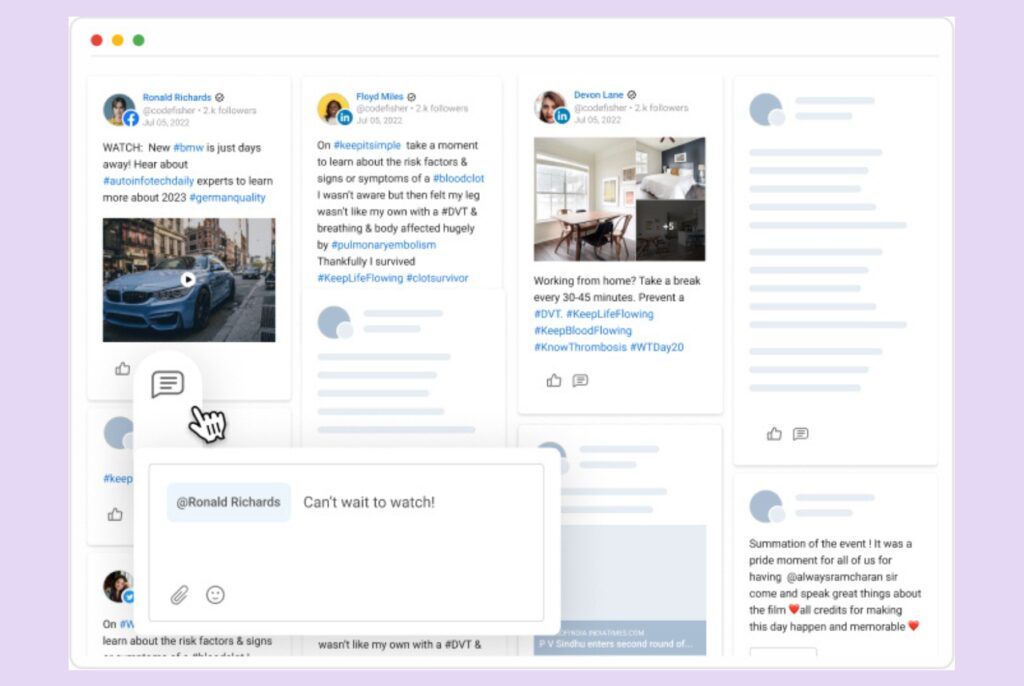
2. Know your audience
Know who you are trying to reach on social media:
- Develop buyer personas to understand your ideal customer.
- Conduct audience research through surveys, social listening, and competitor analysis.
Example: Sarah, a social Media Savvy Entrepreneur.
Include details like her demographics (age, location, occupation), interests (social media trends, marketing tips), online behavior (active on Instagram, reads industry blogs), and pain points (struggling with brand awareness).
3. Choose the right platforms
- Identify where your target audience spends their time.
- Focus on a few key platforms to effectively manage your presence.
Example: LinkedIn is text-heavy and professional, while Instagram and TikTok prioritize visually appealing photos and videos.
4. Develop your content calendar
- Outlines the types of content you’ll post, the frequency of posting, and the platforms where each piece will be shared.
- Experiment with different content formats: text posts, images, videos, stories, live streams, etc.
Content calendar tip: For a tech brand, mix informative blog posts, customer reviews (video!), product feature highlights (images), and industry news.
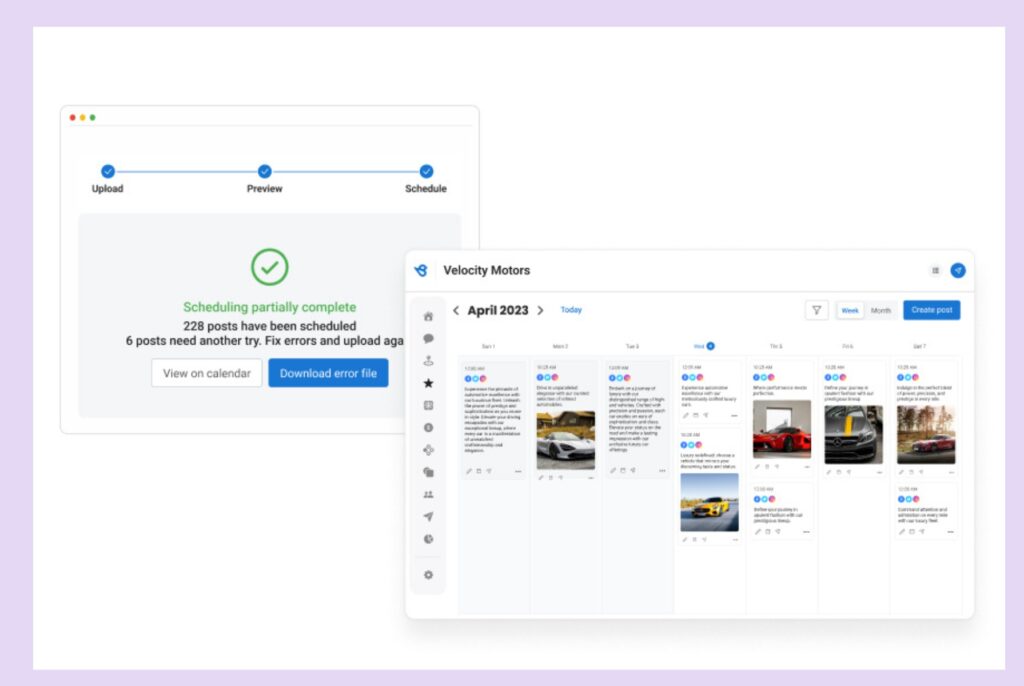
5. Establish your brand voice & tone
Maintain a consistent brand voice and tone across all your social media platforms.
- Consider your brand personality and target audience when determining your voice and tone.
- Will you be informative and professional? Funny and engaging?
6. Optimize your profiles
- Craft compelling bios and descriptions for each platform.
- Use high-quality visuals for your profile pictures and cover photos.
- Include links to your website and other relevant landing pages.
- Utilize relevant keywords in your profiles to improve discoverability.
7. Engage & build relationships
- Respond to comments and messages promptly.
- Run contests, polls, and ask questions to spark conversations.
- Participate in relevant industry conversations and use relevant hashtags.
- Partner with influencers in your niche to reach a wider audience.
8. Analyze & adapt
- Track your results using social media analytics tools.
- Monitor key metrics like reach, engagement, website traffic, and conversion rates.
- Identify what’s working and what’s not.
- Continuously refine your strategy based on your data and audience feedback.
Copy & use: Free social media calendar template
How companies should approach social media content creation
To create content that resonates with their audience, companies should incorporate stories into their content that capture viewers’ attention. They should also strive to be consistent with their messaging by creating a unified brand identity across all social media channels.
Here are some practical, value-based strategies you can consider:
- Leverage AI tools for content ideation and optimization (e.g., ChatGPT for brainstorming, Jasper for copywriting, Canva’s AI features for design).
- Implement various types of social media content, specifically in 5:3:2 ratio: five curated pieces from others, three created pieces, and two personal/humanizing posts.
- Use the “AIDA” framework for posts: Attention, Interest, Desire, and Action.
- Create “evergreen” social content post ideas or pillars that can be repurposed across platforms.
- Develop a brand-specific hashtag strategy (e.g., branded hashtags, niche-specific tags).
- Utilize social listening tools to identify and engage with relevant conversations.
- Implement engagement posts like a “social media takeover” strategy with influencers or employees.
- Create platform-specific content (e.g., Instagram Reels, Twitter Spaces, LinkedIn articles).
- Use data visualization tools to make complex information more digestible.
- Implement a social media crisis management plan.
What is social media crisis management?
Social media crisis management is preparing for, responding to, and mitigating negative events or public relations issues that unfold on social media platforms.
How can businesses prepare for and handle PR issues on social platforms?
Here’s how businesses can prepare for and handle such situations:
Before the crisis:
- Develop a crisis plan and response team
- Create response templates for common scenarios
- Use a robust social media management platform
What is a social media management platform? A social media management platform is a tool that helps businesses efficiently manage their social media presence across multiple networks. Such tools also aid in reputation and crisis management by providing real-time monitoring and alerts for brand mentions, allowing quick responses to potential issues.
Birdeye Social is a robust AI-driven platform that empowers businesses to automate content creation, schedule posts across multiple platforms, and analyze engagement metrics.
During the crisis:
- Respond quickly and transparently
- Use appropriate channels and maintain consistent messaging
- Keep stakeholders informed and updated
- Monitor public sentiment and adjust strategy as needed
After the crisis:
- Conduct a thorough post-mortem analysis
- Update crisis management plan based on lessons learned
- Rebuild trust through positive engagement and transparency
Remember:
- Don’t delete comments: Deleting negative feedback looks bad. Address it and offer solutions.
- Don’t engage in arguments: Stay professional and avoid escalating negativity.
- Learn from the experience: Analyze the crisis to identify areas for improvement in your business communication strategy.

Common social media marketing challenges faced by businesses
Every business faces hurdles when navigating the social media landscape, with a few common ones being:
- Keeping up with algorithm changes
- Negative comments or online criticism
- Creating engaging content consistently
- Measuring results & proving ROI
After working with over 150,000, we at Birdeye have factored the common challenges faced by both multi-location and small businesses and our respective solutions:
Challenges faced by multi-location businesses:
❗Challenge: Maintaining consistent branding across locations.
💡 Solution: Develop clear brand guidelines that define your voice, visuals, and messaging. Utilize social media management tools, like Birdeye Social, for scheduling and content distribution to ensure consistency.
❗Challenge: Managing multiple social media pages.
💡 Solution: Explore platform-specific management tools that allow you to manage content and engagement across all locations from a centralized hub. Consider assigning social media managers at each location to contribute local content while adhering to brand guidelines.
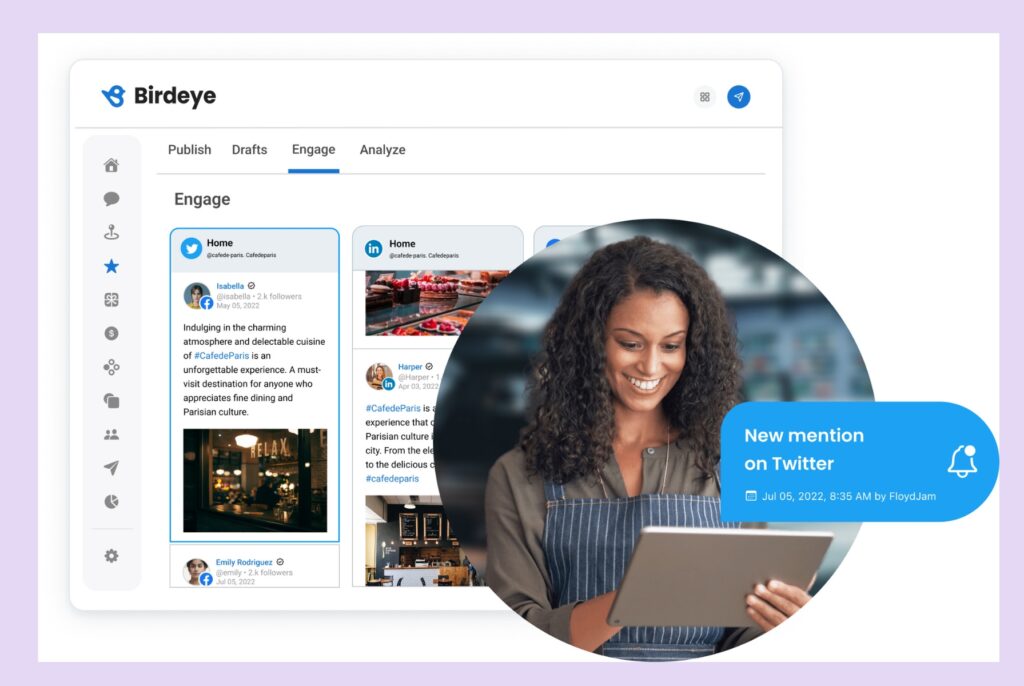
Challenges faced by small businesses:
❗Challenge: Lack of time and resources.
💡Solution: Focus on mastering a few key platforms where your target audience spends their time. Utilize free scheduling tools and content calendars to plan and streamline your social media presence. If resources permit, consider outsourcing specific tasks like content creation or paid advertising.
❗Challenge: Compete with larger brands for attention.
💡Solution: Find your niche! Develop a unique brand voice and focus on creating high-quality, valuable content that resonates with your target audience. Utilize relevant hashtags and participate in trending conversations to gain visibility.
The social media cycle to turn followers into customers
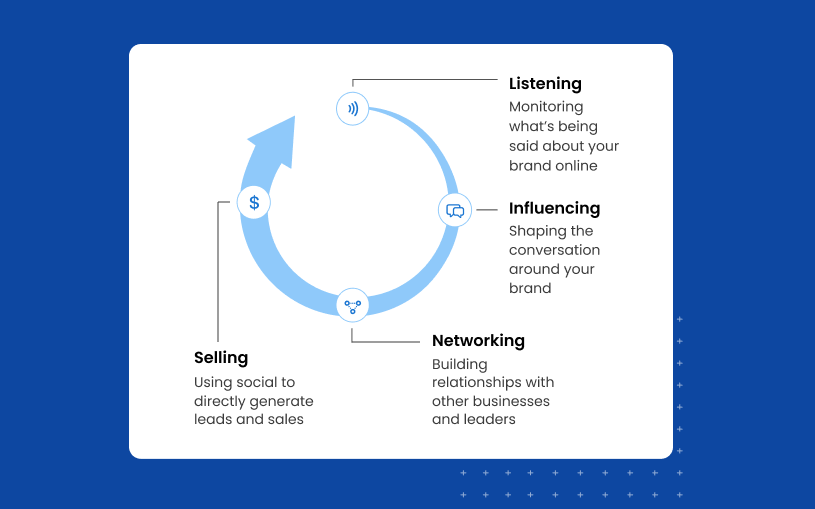
Keeping up with social media can be challenging. Just when you think you’ve got the hang of it, the algorithm changes, or a new platform emerges.
Even though it may seem like a never-ending cycle, there are a few pillars of success you can apply to stay on track. When brought together, these pillars are known as the social media cycle.
They can be broken down into four distinct stages:
1. Social media listening
The first stage of the social media cycle is listening. The purpose of this step is to understand what people are saying about your brand online so you can craft or refine your social media strategy in a way that is relevant to your target audience.
The difference between social media monitoring and social media listening Social listening is the process of actively listening to what people are talking about online and engaging in meaningful conversations with them. It involves monitoring conversations, keywords, and hashtags related to your business and its industry. Social monitoring, on the other hand, is more focused on tracking analytics data such as engagement rates, follower count, and post-performance to measure ROI. It also involves analyzing industry trends to identify growth opportunities.
Examples of social media metrics are click-through rates, conversion rates, impressions, engagement rates (likes, comments, and shares), and leads.
Social media analytics can be broken down into three types:
- Social listening analytics track what is said about the brand.
- Sentiment analysis is the positive, negative, or neutral sentiment around a product or service.
- Influencer analysis identifies key social media influencers in your industry.
These data types can help businesses make necessary changes to improve customer experience and build relationships with potential social media influencers.
2. Social media influencing
Influencing involves using a variety of techniques to make sure that your brand name is at the forefront when people are discussing products and services related to your industry.
This can be achieved through creating and sharing high-quality content, engaging with social media influencers and thought leaders in your industry, and running targeted social media ads.
What are social media analytics? Social media analytics is a process that allows businesses to gain insight into the demographics and engagement of their followers through data analysis. This allows them to create tailored campaigns to resonate with their audience, leading to improved engagement, sales, and growth.
3. Social media networking
Networking can be carried out by joining relevant online communities and forums, engaging in conversations on Twitter and Facebook Groups, attending virtual seminars and webinars, and participating in in-person gatherings such as conferences and meetups.
The aim of this step is to build your reputation as an authority in the field, creating strong relationships that can help you achieve your business goals.
4. Social media selling
There are lots of ways to sell products and services on social media. You can run ads that target people who might want what you’re selling. You can also use social media to get people to visit your website. And you can ask social media influencers with a lot of followers to tell their followers about your product or store.
The goal of social selling is to get followers to become customers who buy your products.
By understanding these four stages of the Social Media Cycle, you can develop a more adaptable and effective social media marketing strategy for your business regardless of the inevitable changes in social media.
What is the best way to analyze data on social media metrics?
The best way to analyze social media metric data is to:
- Define clear KPIs aligned with business goals
- Use AI-powered analytics tools for deeper insights
- Focus on engagement rates and sentiment analysis
- Conduct regular competitor benchmarking
- Analyze content performance across different platforms
Top 4 free social media management tools
With detailed audience insights from platforms like Facebook, Instagram, Twitter, and LinkedIn, you’ll have a better understanding of who your target customers are and how they interact with your content.
Here are the top 4 free social media management tools you must use:
- Facebook Audience Insights: Get demographics, people’s interests, and lifestyles (relationship status and locations).
- Instagram Insights: Learn about follower trends (accounts reached, accounts engaged, and total followers) as well as your content’s overall performance.
- LinkedIn Page Analytics: Get detailed insights into how your page is performing, as well as information on your audience engagement. You can analyze how different types of content are doing, get a breakdown of page visits by location and device, and view overall engagement trends
- Twitter Analytics: Measure engagement of your Tweets and how to get more impact, see the interests, locations, and demographics of your followers. Plus, you can track the success of your Twitter Cards.
Having access to these kinds of insights can help you optimize your social media campaigns for maximum impact.

If you can get all data from free tools, are paid social media management platforms worth the investment?
Having reliable social media management platforms is critical for growing businesses. These social media platforms do more than just save time. They also provide businesses with valuable insights into customer behavior. By understanding how customers interact with content, businesses can make better decisions about what content to produce and when to publish it.
Plus, a good social media management platform will make it easy to track conversions and ROI, which can help justify the cost of the service.
How to choose the right social media management platform
With so many social media management platform options, how do you choose the right one for your business? Here are our recommended suggestions:
Key features to look for:
- User-friendly interface
- Comprehensive functionality (posting, scheduling, monitoring, analytics)
- Bulk posting capabilities
- Engagement and moderation tools
- Integrations with existing systems
- Affordable pricing
- Reliable customer support
- Content optimization features
Action steps:
- List your specific needs and goals
- Research platforms that match your requirements
- Try free trials or demos
- Compare pricing plans
- Read user reviews and case studies
Stand out from competitors:
- Prioritize platforms with AI-driven insights
- Look for advanced sentiment analysis tools
- Choose platforms offering competitor benchmarking
Pro tip: Don't just focus on features - consider scalability as your business grows.
Solve any challenge smartly with Birdeye’s AI-powered social media management tool
Birdeye Social is an AI-powered social media management software that allows you to run your social media platforms almost on autopilot while freeing you to focus more on business and campaigns.
What makes Birdeye’s Social media management platform a must-integrate part of your marketing?
Read how one of our customers benefited ever since using Birdeye Social:
Our customers, their stories: It's so important for each of our practices to share their own personalities so they can keep that authentic local presence. Birdeye Social allows us to post across locations while still connecting with our communities. – Meghan S. Bingham, Senior Operations Manager, Valley Veterinary Care
Struggling to keep up with a steady stream of social media content? Birdeye Social can help plan, publish, and schedule posts in advance to ensure consistent engagement and free up your time for other tasks.
- Feeling overwhelmed by platform changes?
- Struggling with ROI proof?
- Juggling multiple locations?
- Difficulty in tracking all conversations about your business?
Birdeye Social offers AI-powered features to help you overcome all these content creation and engagement challenges with its centralized platform.
Birdeye Social also offers these game-changing features:
- Effortless image sourcing: Find the perfect visual for every post with Birdeye Social’s built-in library of royalty-free images. Plus, you can leverage BirdAI to generate custom images if needed.
- Maintain brand consistency: Build and manage a central library of pre-approved, on-brand images and media for all your locations and accounts. This ensures a consistent visual identity across your social media presence.
- Organize & categorize content: For better analysis, Birdeye Social allows you to tag posts, images, and comments with specific themes, making it easier to track performance and identify trends.
Social media engagement made easy when you:
- Boost engagement & respond in real-time: Never miss a comment or message again. Birdeye Social provides instant notifications and a centralized inbox, allowing you to engage with your followers in real-time.
- Respond in seconds with AI: Don’t waste time crafting responses! Birdeye Social’s AI lets you rapidly draft responses to comments and messages or effortlessly edit existing replies to suit your preferences, ensuring quick and tailored interactions.
- Shrink your links: Shorten long links automatically to make them easier on the eyes and create space for your content.
Use powerful and interactive analytics to get real-time insights:
- Track performance by location: Gain valuable insights into what resonates with your audience across different locations. Birdeye Social tracks top-performing content, social reach, engagement, and audience growth by region, helping you tailor your strategy for optimal results.
Simplify social media management:
- Automatically share your best reviews: Generate buzz for your brand by automatically turning your best reviews into compelling social posts.
- Upload social posts from a spreadsheet: Bulk upload streamlines the social post creation process and reduces errors. Import up to 500 social posts across channels and locations from a spreadsheet and schedule them in a few clicks.
- Boost the visibility of your Google Business Profiles: Attract more customers with Google Posts.
- Attract more users with Apple Business Connect: Create attractive place cards with photos, logos, descriptions, social posts, and limited-time offers.
Latest social media trends & how businesses can adapt
Social media is constantly evolving. Here are some of the hottest social media trends and how businesses can leverage them:
1. Short-form video rules
- Businesses can: Create engaging, bite-sized content showcasing products, tutorials, or behind-the-scenes glimpses on TikTok, Instagram Reels, and YouTube Shorts.
- Adaptation tip: Focus on high-quality visuals, catchy music, and storytelling within seconds.
2. Befriend AI-generated content
- AI can: Generate captions, create personalized ad copy, or personalize social media experiences.
- Businesses can: Utilize AI to streamline content creation and personalize customer interactions.
- Adaptation tip: Let AI be your assistant, not a replacement for human creativity and brand voice.
3. Social commerce continues to boom
- Platforms like: Instagram Shopping, TikTok storefronts, and live shopping events are gaining traction.
- Businesses can: Make shopping seamless by integrating social media with their online stores.
- Adaptation tip: Showcase products creatively, leverage influencers, and offer exclusive deals for social media followers.
4. Prioritizing community over just followers
- Focus on: Building meaningful connections and fostering a loyal audience.
- Businesses can: Encourage user-generated content, respond to comments promptly, and host online events.
- Adaptation tip: Shift from “broadcasting” to “conversations” and actively engage with your audience.
5. The power of authenticity & transparency
- Customers value: Genuine connections and brands taking a stand on social issues.
- Businesses can: Show their human side, address concerns openly, and support causes they believe in.
- Adaptation tip: Be relatable, own your mistakes, and use social media to connect with your audience more deeply.
Bonus trend: Livestreaming is here to stay. Host Q&A sessions, product demonstrations, or behind-the-scenes tours to boost engagement.
FAQs about social media management
Social media management involves creating, scheduling, analyzing, and engaging with content on social media platforms. It includes strategy development, content creation, community engagement, and performance tracking to achieve business goals through social channels.
How much you pay a social media manager will depend on location and responsibilities. However, it’s estimated that a social media manager in the United States can make anywhere from $40K – $160K per year. Or between $14-35 an hour.
To start social media management, you’ll need to identify your target audience and define the goals or objectives that you hope to achieve. Next, develop a content strategy and create a calendar for scheduling posts. After setting up your social media accounts on various social platforms, you can start publishing content, engaging with followers, responding to inquiries and feedback, researching industry trends and competitors, optimizing profiles for search engine visibility, promoting special offers or campaigns, and amplifying reach with paid advertising.
Social media management can involve creating and managing accounts on multiple platforms, such as Facebook, Instagram, Twitter, LinkedIn, and YouTube. This can include posting content, engaging with followers, responding to inquiries and feedback, optimizing profiles for search engine visibility, and promoting special offers or campaigns.
Posting frequency varies by platform and audience. Generally, aim for 1-2 posts daily on Facebook, 3-5 tweets on Twitter, 1-2 posts on LinkedIn, and 1-3 posts on Instagram. Consistency matters more than volume. Monitor engagement to find your optimal posting frequency.
Measure social media ROI by tracking key metrics like engagement rate, click-through rate, conversions, and revenue generated from social campaigns. Use platform analytics and UTM parameters to attribute results. Compare social media costs to the value generated to calculate ROI.
Optimal posting times vary by platform and audience. Generally, weekdays between 9 AM and 3 PM work well. For B2B, try Tuesday-Thursday mornings. For B2C, weekends can be effective. Use platform analytics to determine when your audience is most active and experiment to find your best times.
Create a social media content calendar by planning content themes, post types, and frequency for each platform. Use a spreadsheet or management tool to organize ideas, schedule posts, and track performance. Include a mix of promotional, educational, and engaging content.
Depends on your business size & social media goals. Consider in-house resources vs. agencies.
Freelancers: $500-$2000/month. Agencies: vary based on services & needs.
Simplify social media management with Birdeye
So, what’s our main social media management advice for turning followers into customers?
Focus on creating valuable content that solves follower problems.
With Birdeye Social, you can seamlessly do that and elevate your social media presence to improve your online reputation management.
Use our all-in-one platform to execute all admin tasks so you can focus more on doing what’s best for your business: Making profits!
Read how one of our customers benefited ever since using Birdeye Social:
Our customers, their stories: It has been so efficient to post advertising onto our multiple social platforms from 1 central location! We also find it really convenient to have various templates established for different client types. – Christina Lamotta, Marketing Manager, PRD Panania
Integrating Birdeye will keep your business ahead of the competition and at the top of search results.
For more information about Birdeye, watch our demo or schedule time with a Birdeye product specialist.
This blog post is part of our Social Media Management Guide

Originally published









